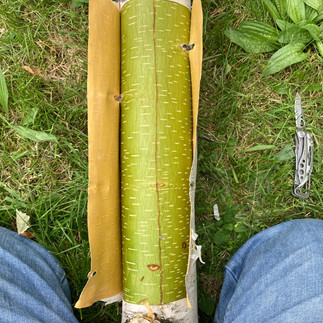We have many birch trees at our house and when we pruned off some large lower branches I was able to pull off the bark in sheets to use in future art projects.
Let's start with a little biology. The white layer on the birch tree is the outer bark. The green layer you see underneath is the inner bark or phloem. The phloem is the vascular system that carries sugars made from photosynthesis in the leaves to the rest of the tree. Cutting the phloem horizontally, thereby severing the vascular system, can kill the tree and will certainly kill it if done in a full ring around the trunk. I advise any inexperienced birch bark harvesters to work only with pruned branches, previously downed trees/wood, or trees that are slated to be removed.
In this case, I was working with branches pruned from a Birch tree infected with the Bronze Birch Borer. As this insect infects and sometimes kills birches throughout Portland and Oregon it presents opportunities for bark foraging. I am a strong proponent of using what is abundant in your area from neighborhood yard waste to invasive species. Local discarded abundance is one of my main sources of inspiration.
Birch bark has been used as paper for centuries. It was also used by Native Americans for baskets, canoes, and other essential items. Buddhist manuscripts written on birch bark dating from the 1st century are likely the oldest Indic texts. Other examples of old birth bark manuscripts have been discovered in Russian and Ireland. Here is a detailed account of the conservation process for one such birch bark manuscript.
The process of harvesting the bark is pretty straight forward. The most important thing I learned is that the bark paper comes off easily if removed the same day, and preferably within a few hours of the time to branch was cut from the tree. Once the bark and wood have a chance to dry out the paper does not peel off as cleanly. However, on my recent trip to the east coast I saw many fallen birch trees with the outer bark detached and laying on the ground or the log itself. So older birch logs are also a good source of birch bark paper.
To harvest from a freshly pruned branch use a sharp knife to score the bark vertically, parallel to the pruned branch. The goal is to cut through the thin layer of papery bark down to the green inner bark. Again, please do not do this to a live tree unless you have experience or guidance with this practice. I also made small horizontal scoring marks on the "top" and "bottom" of my sheet so it would tear evenly. If you have scored it deeply enough the paper layer will peel up easily at the intersection of these cuts. From there take your time and continue to peel the bark around the circumference of the branch. The paper around the knots can be a bit challenging. You can peel in such a way that they stay on branch, leaving a hole in the paper, or carefully pry the bark around the knot off with your knife so the thicker knot adjacent bark comes off with your sheet of paper. The birch bark paper has many layers. In the last photo you can see the upper portion of bark delaminated and peeled off in-between layers. The layers can be separated after the bark is removed if you want thinner sheets. They are held together by a resin produced by the tree.
After harvesting the bark dry it flat under pressure, such as under a book. If dried without pressure it will roll. To flatten it at a later date moisten on both sides, gently flatten, and dry flat under pressure.
I am just starting to explore the possibilities of using birch bark with inks, paints, and crayons. I will create more posts as I learn more.


















